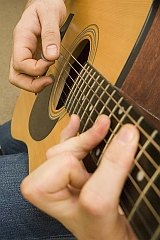I am a strong believer that almost anyone can learn how to play acoustic guitar as long as they are willing to put some time into it. From my experience as a guitar player I've noticed that most people that never quite make it are the ones that give up within the first two months, but 99% of people that survive their first stage of learning the guitar almost always go on to become great guitar players.
I have put together a very simple tutorial for people that are interested in learning acoustic guitar and don't know where to begin. In three easy steps you will be able to learn to play guitar in as little as three months if you do it properly.
Step 1 – Tuning.
Before you do anything else, you will need to be able to properly tune your guitar. This is easy since there are mobile phone apps, PC programs and electronic tuners available that will help you. If you wish to learn naturally then it's very easy to do. However, you will have to be able to hear the correct pitch. This will take time.
The thickest string, which is the string nearest to you as you look down on the guitar should be an E note. After a while you will know what this note should sound like, but until then you should be able to find an example of it online.
Every string down should sound exactly the same as the previous string being played on the 5th fret (frets are the steel sections on your fretboard). So when you play the top string on the 5th fret, the next string down should sound the same when played open (meaning you do not depress the string). There is only one string which is the exception, the third string from the bottom should be played on the 4th fret, and the 5th string down should sound the same.
So, let's just go over that again. Play the 5th fret of the top string, then play the next string down open. Turn your machine head on the next string until the note is the same. When you get to the 3rd string from the bottom, play the 4th fret.
Step 2 – Learn a simple strumming tune.
Now, that the tuning is out of the way, let's take a look at what you can play.
The easiest skill to learn is rhythm guitar, which is just basic strumming. Once you are proficient with forming easy open chords and strumming them, you can try the more advanced techniques such as finger picking.
To begin with you need to select a few songs (so you don't get bored of learning just one tune) that use basic rhythm guitar.
Songs that would fit this description would include:
Knockin' On Heavens Door by Bob Dylan.
Redemption song by Bob Marley.
And any other song which uses a simple pattern of open chords, all I mean by “open” is that some of the strings will be left open, which means you are not using a barre chord.
We will take a look at the first example song, Knockin' On Heavens Door. This uses 3 simple open chords. An open G, D and C. These simple chords can be formed with just 3 fingers on your left hand. Find a chord diagram online and learn the correct finger position.
The next thing you will need to learn is a strumming pattern with your right hand. This is done using alternating strokes, going up and down with your plectrum. On the strokes where you do not play the strings, you will need to ghost past them, but still move your right arm up and down.
You can find the strumming pattern for this song online, or you can learn it by ear, using trial and error. When you are playing the C and the D chords, try and avoid hitting the top string for the C and the top two strings for the D.
Step 3 – Practice And Learn New Techniques
Now, that you have these simple strumming songs to master, you have learned how to play acoustic guitar on a very basic level. You must now practice this pattern until you can do it without any errors. This may take a while and may even cause your fingers to hurt at first, but stick with it. The trick is to practice for no longer than fifteen minutes a day, everyday. Doing so will allow for a finger muscle memory to develop and also you will develop calluses on your fingertips, so playing guitar won't hurt as much as it did at first.
Once you have mastered strumming, you can move on to learning more advanced techniques such as finger picking, picking individual notes with a plectrum and forming bar chords. When you have mastered all these techniques you have successfully learned how to play acoustic guitar to a reasonable standard.
Playing guitar is not the same as riding a bike, once you stop playing it you will start to forget how to play certain tunes. That is why it is important that you keep up with your practice every day, even if it is just for a few minutes.
John Sizemore has been playing & teaching guitar for over 20 years and is the owner and operator of a website featuring lessons on how to play guitar and Beginner Guitar Reviews. Here's the latest: Yamaha FG700s Review
